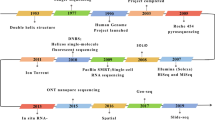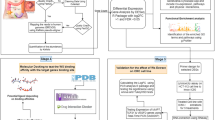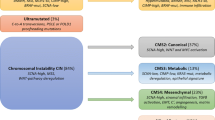Abstract
Copy number variations (CNVs) are key contributors in breast cancer initiation and progression. However, to date, no CNV-based gene signature is developed for breast cancer. 21-gene Oncotype DX, a clinically validated signature, was identified using only RNA expression data in breast cancer patients. In this study, we evaluated whether CNVs of Oncotype DX genes can be used to predict the prognosis of breast cancer patients. Transcriptomic data of 547 and genomic data of 816 of breast cancer patients were downloaded from The Cancer Genome Atlas database. To establish the prognostic relevance between the CNVs of Oncotype DX genes and clinicopathological features, statistical analysis including Pearson Correlation, Fisher-exact, Chi square, Kaplan–Meier survival and Cox regression analyses were performed. 86% genes showed positive CNV-expression correlation. CNVs in 52% and 47.6% genes showed association with ER+ and PR+ status, respectively. 71% of the genes (including ERBB2, CTSV, CD68, GRB7, MKI67, MMP1, PGR, RPLP0, TFRC, BAG1, BCL2, BIRC5, FLNB, GSTM1 and SCUBE2) showed association with poor overall survival. 14% of the genes (including CTSV, RPLP0 and BIRC5) genes showed association with disease free survival. Cox regression analysis revealed ESR1, metastasis and node stage as independent prognostic factors for overall survival of breast cancer patients. The results suggested that CNV-based assay of Oncotype DX genes can be used to predict the survival of breast cancer patients. In future, identifying new gene signatures for better breast cancer prognosis using CNV level information will be worth investigating.



Similar content being viewed by others
References
Key TJ, Verkasalo PK, Banks E (2001) Epidemiology of breast cancer. Lancet Oncol 2:133–140. https://doi.org/10.1016/S1470-2045(00)00254-0
Oakman C, Bessi S, Zafarana E et al (2009) Recent advances in systemic therapy. New diagnostics and biological predictors of outcome in early breast cancer. Breast Cancer Res 11:205. https://doi.org/10.1186/bcr2238
Kheirandish S, Homaee F (2015) Ki-67 protein: a proliferation index in breast cancer. Rev Clin Med 2:205–208. https://doi.org/10.17463/RCM.2015.04.010
Bianchini G, Pusztai L, Karn T et al (2013) Proliferation and estrogen signaling can distinguish patients at risk for early versus late relapse among estrogen receptor positive breast cancers. Breast Cancer Res 15:R86. https://doi.org/10.1186/bcr3481
Gray RG, Quirke P, Handley K et al (2011) Validation study of a quantitative multigene reverse transcriptase–polymerase chain reaction assay for assessment of recurrence risk in patients with stage II colon cancer. J Clin Oncol 29:4611–4619. https://doi.org/10.1200/JCO.2010.32.8732
Howell A, Anderson AS, Clarke RB et al (2014) Risk determination and prevention of breast cancer. Breast Cancer Res 16:446. https://doi.org/10.1186/s13058-014-0446-2
Hannemann J, Velds A, Halfwerk JB et al (2006) Classification of ductal carcinoma in situ by gene expression profiling. Breast Cancer Res 8:R61. https://doi.org/10.1186/bcr1613
Urruticoechea A, Smith IE, Dowsett M (2005) Proliferation marker Ki-67 in early breast cancer. J Clin Oncol 23:7212–7220. https://doi.org/10.1200/JCO.2005.07.501
Kosari F, Cheville JC, Ida CM et al (2012) Shared gene expression alterations in prostate cancer and histologically benign prostate from patients with prostate cancer. Am J Pathol 181:34–42. https://doi.org/10.1016/j.ajpath.2012.03.043
Weigel MT, Dowsett M (2010) Current and emerging biomarkers in breast cancer: prognosis and prediction. Endocr Relat Cancer 17:R245–R262. https://doi.org/10.1677/ERC-10-0136
Arranz EE, Vara JÁF, Gámez-Pozo A, Zamora P (2012) Gene signatures in breast cancer: current and future uses. Transl Oncol 5:398–403
Győrffy B, Hatzis C, Sanft T et al (2015) Multigene prognostic tests in breast cancer: past, present, future. Breast Cancer Res 17:11. https://doi.org/10.1186/s13058-015-0514-2
Perreard L, Fan C, Quackenbush JF et al (2006) Classification and risk stratification of invasive breast carcinomas using a real-time quantitative RT-PCR assay. Breast Cancer Res 8:R23. https://doi.org/10.1186/bcr1399
Fatima A, Tariq F, Malik MFA et al (2017) Copy number profiling of MammaPrint™ genes reveals association with the prognosis of breast cancer patients. J Breast Cancer 20:246–253. https://doi.org/10.4048/jbc.2017.20.3.246
Alvarado MD, Prasad C, Rothney M et al (2015) A prospective comparison of the 21-gene recurrence score and the PAM50-based prosigna in estrogen receptor-positive early-stage breast cancer. Adv Ther 32:1237–1247. https://doi.org/10.1007/s12325-015-0269-2
Cope LM, Irizarry RA, Jaffee HA et al (2004) A benchmark for Affymetrix GeneChip expression measures. Bioinformatics 20:323–331. https://doi.org/10.1093/bioinformatics/btg410
Hester SD, Reid L, Nowak N et al (2009) Comparison of comparative genomic hybridization technologies across microarray platforms. J Biomol Tech JBT 20:135–151
Mermel CH, Schumacher SE, Hill B et al (2011) GISTIC2.0 facilitates sensitive and confident localization of the targets of focal somatic copy-number alteration in human cancers. Genome Biol 12:R41. https://doi.org/10.1186/gb-2011-12-4-r41
Schaschl H, Aitman TJ, Vyse TJ (2009) Copy number variation in the human genome and its implication in autoimmunity. Clin Amp Exp Immunol 156:12–16. https://doi.org/10.1111/j.1365-2249.2008.03865.x
Turner BC, Krajewski S, Krajewska M et al (2001) BAG-1: a novel biomarker predicting long-term survival in early-stage breast cancer. J Clin Oncol 19:992–1000. https://doi.org/10.1200/JCO.2001.19.4.992
Xu Y, Bismar TA, Su J et al (2010) Filamin A regulates focal adhesion disassembly and suppresses breast cancer cell migration and invasion. J Exp Med 207:2421–2437. https://doi.org/10.1084/jem.20100433
Song Z, Shao C, Feng C et al (2016) Association of glutathione S-transferase T1, M1, and P1 polymorphisms in the breast cancer risk: a meta-analysis. Ther Clin Risk Manag 12:763–769. https://doi.org/10.2147/TCRM.S104339
Yu C, Hequn C, Longfei L et al (2017) GSTM1 and GSTT1 polymorphisms are associated with increased bladder cancer risk: evidence from updated meta-analysis. Oncotarget 8:3246–3258. https://doi.org/10.18632/oncotarget.13702
Tian S, Roepman P, van’t Veer LJ et al (2010) Biological functions of the genes in the Mammaprint breast Cancer profile reflect the hallmarks of cancer. Biomark Insights 5:129–138. https://doi.org/10.4137/BMI.S6184
Rumney RMH, Coffelt SB, Neale TA et al (2017) PyMT-Maclow: a novel, inducible, murine model for determining the role of CD68 positive cells in breast tumor development. PloS One 12:e0188591. https://doi.org/10.1371/journal.pone.0188591
Sudhan DR, Rabaglino MB, Wood CE, Siemann DW (2016) Cathepsin l in tumor angiogenesis and its therapeutic intervention by the small molecule inhibitor KGP94. Clin Exp Metastasis 33:461–473. https://doi.org/10.1007/s10585-016-9790-1
Nadler Y, González AM, Camp RL et al (2010) Growth factor receptor-bound protein-7 (Grb7) as a prognostic marker and therapeutic target in breast cancer. Ann Oncol Off J Eur Soc Med Oncol 21:466–473. https://doi.org/10.1093/annonc/mdp346
Thakur SS, Li H, Chan AMY et al (2018) The use of automated Ki67 analysis to predict Oncotype DX risk-of-recurrence categories in early-stage breast cancer. PLoS ONE 13:e0188983. https://doi.org/10.1371/journal.pone.0188983
Wang J, Ye C, Lu D et al (2017) Matrix metalloproteinase-1 expression in breast carcinoma: a marker for unfavorable prognosis. Oncotarget 8:91379–91390. https://doi.org/10.18632/oncotarget.20557
Yokoi A, Yoshioka Y, Yamamoto Y et al (2017) Malignant extracellular vesicles carrying MMP1 mRNA facilitate peritoneal dissemination in ovarian cancer. Nat Commun 8:14470. https://doi.org/10.1038/ncomms14470
McNeill RE, Miller N, Kerin MJ (2007) Evaluation and validation of candidate endogenous control genes for real-time quantitative PCR studies of breast cancer. BMC Mol Biol 8:107. https://doi.org/10.1186/1471-2199-8-107
Sugyo A, Tsuji AB, Sudo H et al (2017) Uptake of 111In-labeled fully human monoclonal antibody TSP-A18 reflects transferrin receptor expression in normal organs and tissues of mice. Oncol Rep 37:1529–1536. https://doi.org/10.3892/or.2017.5412
Acknowledgements
I would like to thank all the authors for actively participating in the project. This project is supported by Higher Education Commission (HEC) of Pakistan.
Author information
Authors and Affiliations
Corresponding author
Ethics declarations
Conflict of interest
All authors state that they have no conflicts of interest.
Electronic supplementary material
Below is the link to the electronic supplementary material.
Rights and permissions
About this article
Cite this article
Ahmed, W., Malik, M.F.A., Saeed, M. et al. Copy number profiling of Oncotype DX genes reveals association with survival of breast cancer patients. Mol Biol Rep 45, 2185–2192 (2018). https://doi.org/10.1007/s11033-018-4379-1
Received:
Accepted:
Published:
Issue Date:
DOI: https://doi.org/10.1007/s11033-018-4379-1




